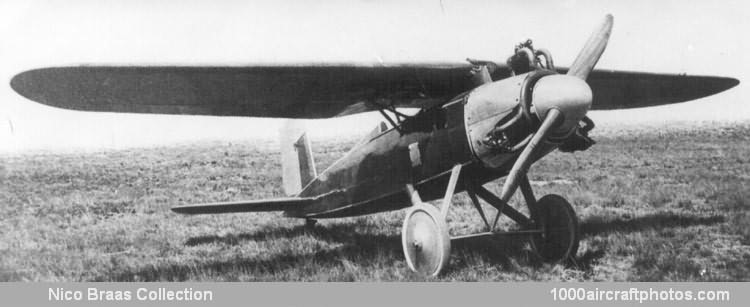The Albatros Flugzeugwerke GmbH at Johannisthal, Berlin, Germany, was probably one of the first firms in the world to make extensive use of plywood construction, dating as far back as 1913. Schubert used three-ply not only for covering the fuselage, but the greater portion of the wing, although the hinged trailing edge and ailerons were steel tube structures covered with fabric. The whole trailing edge was hinged, and a variable camber gear was incorporated in the design. The ailerons were operated by torque rods and cranks.
An unusual feature in the design was the three-point suspension mounting of the wing, by which it could be dismantled easily. The front spar was supported at one point only by a form of fin built integral out of the fuselage, while the rear spar had two steel bracket supports, one on each side, raked outwards from the top of the fuselage. The pilot's open cockpit was located under the trailing edge of the wing, while the passenger's open cockpit was immediately under the wing, accessed through a trap door in the wing itself.
With a horn-balanced rudder, the tail of the L.69 was of normal construction, although the fuselage came to a point at the back, this cone was detachable to give access to the control levers, etc. The tail skid moved with the rudder for steering on the ground. The landing gear was of conventional type, and was in the form of steel tubes with streamline fairings.
Only four aircraft were built, two L-69s, fitted with the 100 hp Bristol Lucifer three-cylinder air-cooled radial engine, and two L-69a's, fitted with the 110 hp Siemens-Halske Sh 12 nine-cylinder air-cooled radial engine. The engine was mounted on a tubular steel structure attached to the main fuselage at four points, but could be swung out to give access to the back of the engine for inspection. Considerable care was taken to streamline the Lucifer engine (as pictured here), and a large spinner was placed over the airscrew boss. The petrol tank was mounted in the center section of the wing.
Built in 1925, the two L-69s were registered D-679 (c/n 10042) and D-684 (c/n unknown), and the two L-69a's were registered D-778 (c/n 10071) and D-1533 (c/n 10072). D-778 was registered to the DVL (Deutsche Versuchsanstalt für Luftfahrt, German Aviation Laboratory) at Johannisthal, only two years later, April 1929, it was dismantled. D-1533 was registered to the Albatros company in November 1928, it was scrapped in January 1931.
On September 19-20, 1925, one of the two L-69s participated in the Sachsenrundflug (Round Saxony Flight), this consisted of two 320 mls (515 km) laps of the circuit Chemnitz-Plauen-Leipzig-Grossenhain-Bautzen-Zittau-Dresden-Chemnitz. Flown by Mr. Student, the aircraft placed first in the Class D (engine of more than 100 hp) in 6 hr 14 min, with an average speed of 102.68 mph (165.24 kmh). This was significantly faster than the Albatros L-68 (7 hr 57 min, 80.5 mph, 129.56 kmh) which placed second, or the third, an Udet U 12 Flamingo (8 hr 28 min, 75.59 mph, 121.65 kmh)."
The following data relate to the L-69.
